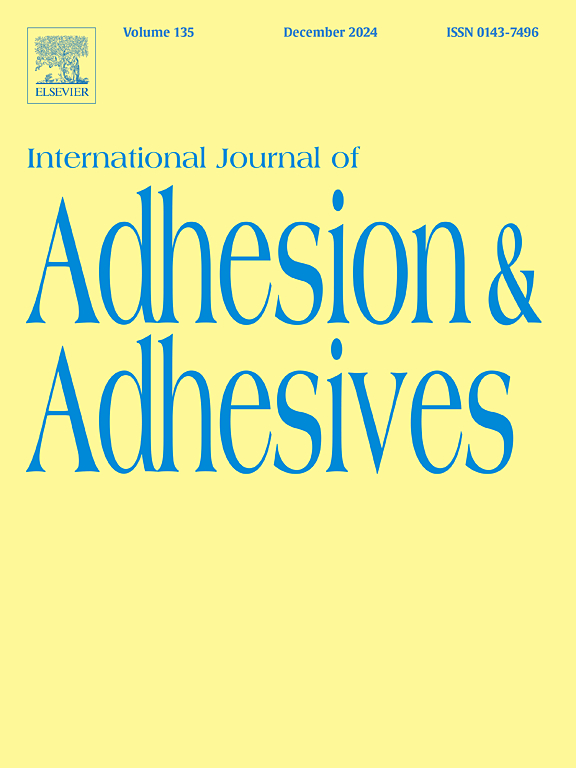硝酸和氢氟酸溶液及二氧化硅涂层对水泥表面粗糙度及与钇稳定氧化锆的附着力的影响
IF 3.2
3区 材料科学
Q2 ENGINEERING, CHEMICAL
International Journal of Adhesion and Adhesives
Pub Date : 2025-05-17
DOI:10.1016/j.ijadhadh.2025.104051
引用次数: 0
摘要
研究了硝酸和氢氟酸溶液中不同酸蚀时间对水泥表面粗糙度和对氧化锆(4YSZ)附着力的影响,并与二氧化硅涂层的结果进行了比较。氧化锆样品(IPS e.max ZirCAD MT) (N = 192,每组N = 12)随机分为两种表面处理方法:a)二氧化硅涂层(CoJet) (20 s, 2.5 MPa) (SC)和b)酸蚀(Zircos E, ZE)。蚀刻30分钟,1小时和2小时。经过元素分析(能谱分析,EDS),表面粗糙度(Ra, Rz, Rv, Rc, RzJIS, Rp)测量(3D显微镜),将两个粘合剂连接系统(PV: Panavia 21和ML: Multilink Hybrid Abutment)粘接在条件反射的基底上。一半的样品干燥测试,另一半在热循环(x6000循环,5-55°C)条件下测试。剪切粘接强度(SBS)在万能试验机(1 mm/min)上测量。用三维数码显微镜分析失效模式。数据分析采用双因素方差分析、Tukey事后检验和Pearson相关检验(α = 0.05)。对于Ra、Rz、Rv和Rc,仅ZE处理30 min产生的表面粗糙度与SC相似,但RzJIS和Rp参数的值更高。干燥条件下各组SBS结果均不显著(19.38 + 5.35-14.5 + 7.39)(p >;0.05)。在干燥和高温条件下,粗糙度参数与SC和ZE (30 min、1h和2h)的相关性较弱或呈负相关,而对于PV, SC和ZE (2h)的相关性中等至强,而ZE (30 min)和ZE (1h)的相关性较弱或混合。衰老后,SBS在所有组中下降了12 - 66%,所有条件和药物的失败类型都是更常见的混合失败类型(50 - 100%)。在硝酸和氢氟酸溶液中蚀刻30分钟,可以考虑替代二氧化硅涂层,以改善所测树脂水泥与4YSZ陶瓷的附着力,前提是在老化后,观察到所有组合的附着力都有所下降。本文章由计算机程序翻译,如有差异,请以英文原文为准。
Effect of nitric and hydrofluoric acid solution and silica-coating on surface roughness and adhesion of luting cements to yttrium-stabilized zirconia
This study investigated the effect of varying acid etching durations using nitric and hydrofluoric acid solution on the surface roughness and adhesion of luting cements to 4-mol yttria-stabilized zirconia (4YSZ) and compared the results with those of silica coating. Zirconia specimens (IPS e.max ZirCAD MT) (N = 192, n = 12 per group) were randomly assigned to two surface conditioning methods: a) silica coating (CoJet) (20 s, 2.5 MPa) (SC) and b) acid etching (Zircos E, ZE). Etching was performed for 30 min, 1 h, and 2 h. After elemental analysis (energy-dispersive spectroscopy, EDS), surface roughness (Ra, Rz, Rv, and Rc, RzJIS, Rp) measurements (3D microscopy), two adhesive luting systems (PV: Panavia 21 and ML: Multilink Hybrid Abutment) were bonded onto the conditioned substrates. Half of the specimens were tested dry, and the other half were tested after thermocycling (x6000 cycles, 5–55 °C) conditions. Shear bond strength (SBS) was measured in a universal testing machine (1 mm/min). Failure modes were analyzed using 3D digital microscopy. Data were analyzed using 2-way ANOVA, Tukey's post-hoc, and Pearson's correlation tests (α = 0.05). Only ZE for 30 min produced surface roughness similar to that of SC for the Ra, Rz, Rv, and Rc, but showed higher values for the RzJIS and Rp parameters. SBS results were not significant in Dry conditions in all groups (19.38 + 5.35–14.5 + 7.39) (p > 0.05). While for ML, roughness parameters showed mostly weak or negative correlations for SC and ZE (30 min, 1 h, and 2 h) under both Dry and TC conditions, for PV, a moderate to strong positive correlation was observed in SC and ZE (2h) after TC, with weaker or mixed trends in ZE (30 min) and ZE (1h). After aging, SBS decreased by 12–66 % across all groups, and failure types were more frequently mixed types of failures (50–100 %) for all conditions and luting agents. Etching with a nitric and hydrofluoric acid solution for 30 min can be considered an alternative to silica coating to improve adhesion to 4YSZ ceramic with the tested resin cements, provided that after aging, a decrease in adhesion was observed in all combinations.
求助全文
通过发布文献求助,成功后即可免费获取论文全文。
去求助
来源期刊

International Journal of Adhesion and Adhesives
工程技术-材料科学:综合
CiteScore
6.90
自引率
8.80%
发文量
200
审稿时长
8.3 months
期刊介绍:
The International Journal of Adhesion and Adhesives draws together the many aspects of the science and technology of adhesive materials, from fundamental research and development work to industrial applications. Subject areas covered include: interfacial interactions, surface chemistry, methods of testing, accumulation of test data on physical and mechanical properties, environmental effects, new adhesive materials, sealants, design of bonded joints, and manufacturing technology.
 求助内容:
求助内容: 应助结果提醒方式:
应助结果提醒方式:


